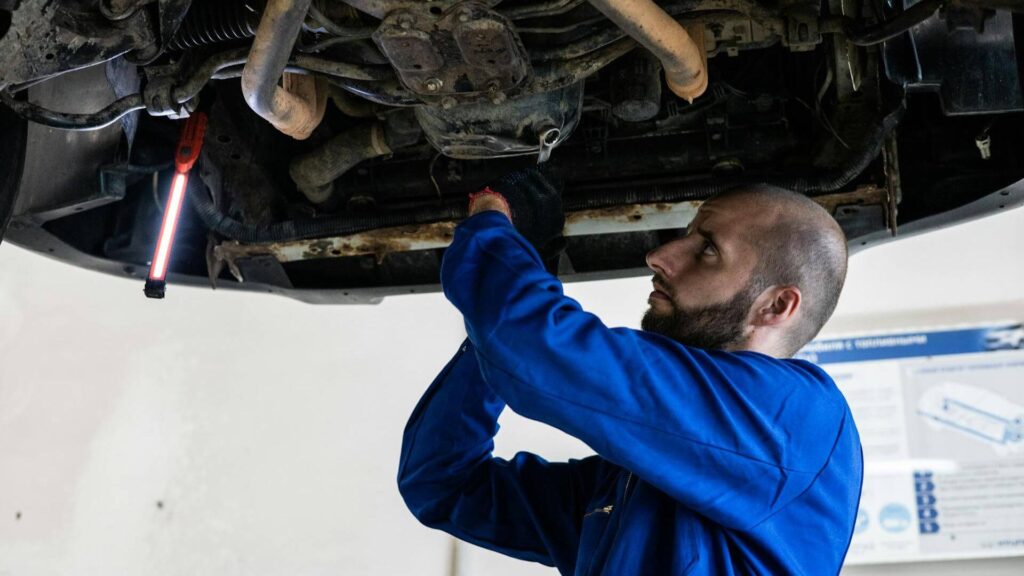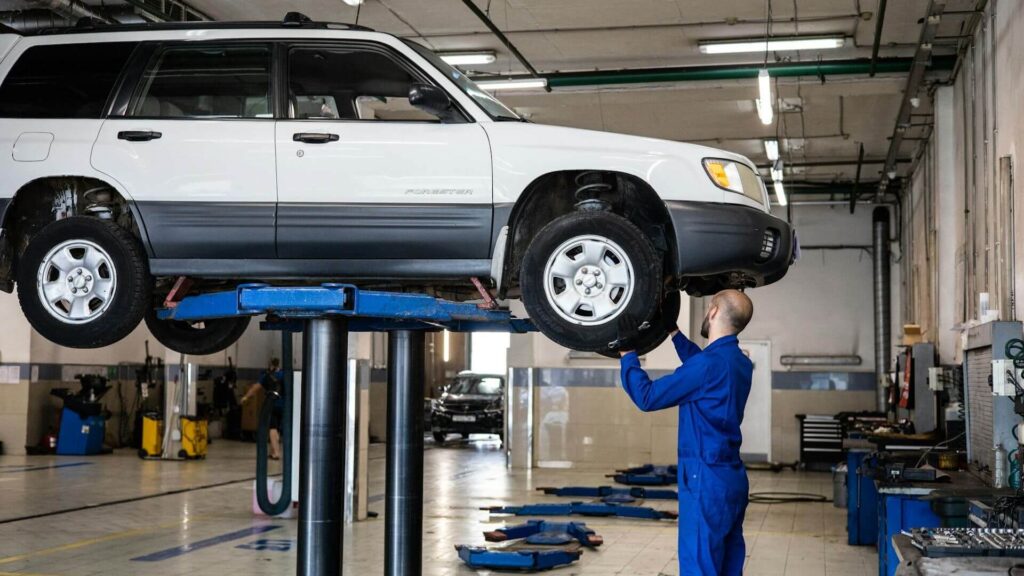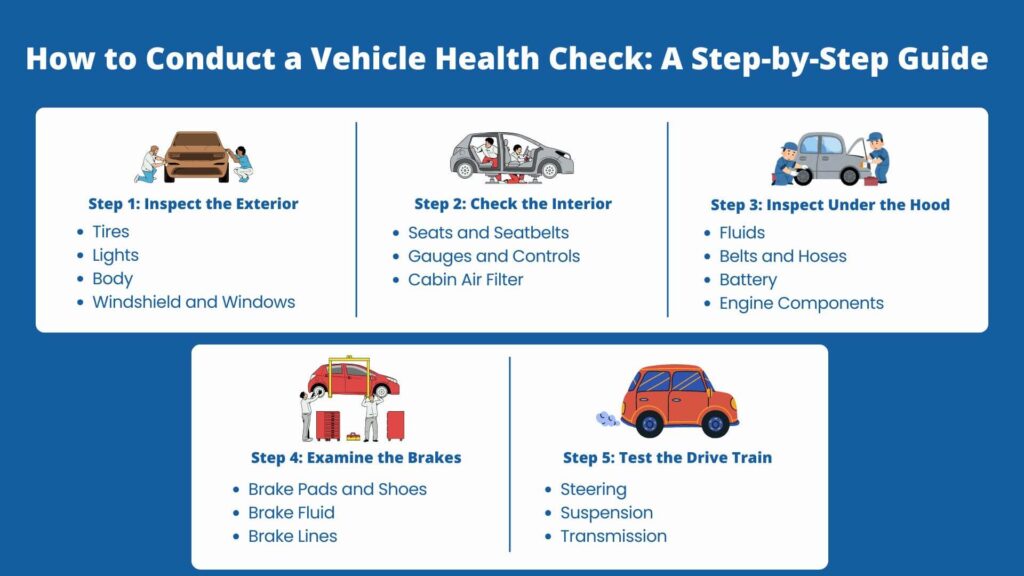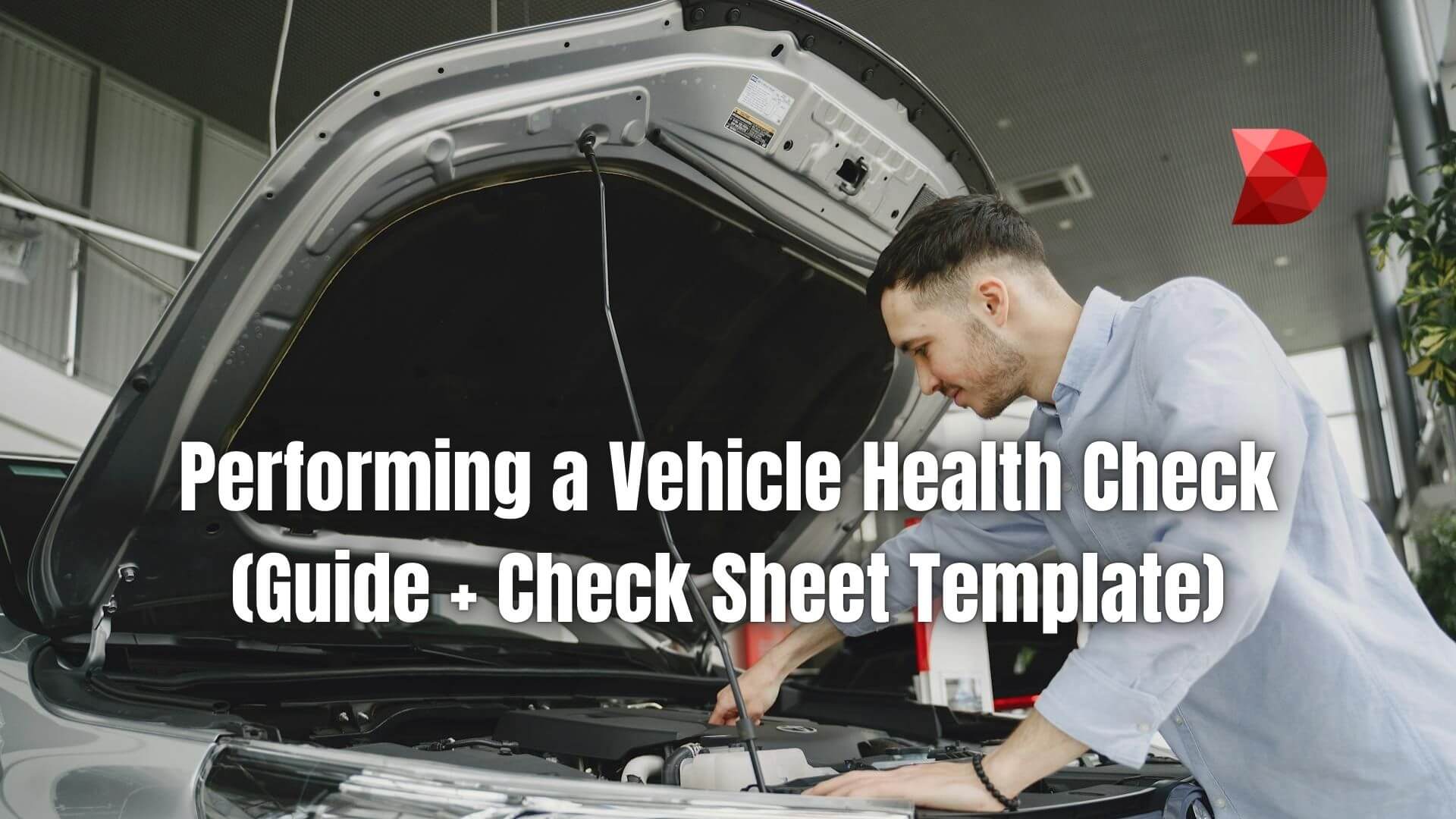Keeping your vehicle in good condition is essential for safety, performance, and reliability. A vehicle health check sheet is a great tool for tracking the condition of your car or truck. This document enables you to identify potential problems before they become serious and costly.
A vehicle health check sheet can save you time and money by helping to ensure that your vehicle remains safe, reliable, and efficient through regular inspections and maintenance. This guide will discuss what goes into creating a practical vehicle health check sheet and how to use it properly.
Table of Contents
ToggleWhat is a Vehicle Health Check?

A vehicle health check is a comprehensive examination of an automobile’s major components. It helps to ensure that a vehicle is running properly and safely and can spot potential issues before they become significant problems.
A vehicle health check should cover components such as brakes, oil levels, tire pressure, and other vital engine parts. During the inspection, certified mechanics will also look for signs of wear and tear in other parts of your vehicle, such as the cooling system, belts, and hoses.
Regular vehicle health checks can help keep your car running smoothly for longer periods with fewer unexpected breakdowns. Therefore, it’s essential to maintain a regular schedule of preventative maintenance that includes having your vehicle inspected at least once per year or every 12,000 miles (whichever comes first).
The Importance of Conducting Vehicle Health Checks
Keeping your vehicle in top shape is an important responsibility when driving. Regular vehicle health checks are one of the main ways to ensure your vehicle runs smoothly, safely, and efficiently.
Conducting regular health checks on your vehicle is essential for extended reliability and safety, from checking the tire pressure and fluid levels to inspecting all the vital components of your engine.
Here are just a few reasons why you should make sure you’re conducting regular vehicle health checks:
Safety
A thorough check of all major components will help spot potential issues that, if left unchecked, can lead to costly repairs or even accidents. It’s better to address any notices quickly before they become an issue while on the road.
Prolonged Reliability
Doing a full vehicle check can prevent unexpected breakdowns due to preventable issues such as low oil levels, worn brake pads, or worn-out tires and belts. With regular checks, you can ensure your vehicle will remain running smoothly for a long time.
Improved Efficiency
Regular checkups of your car’s components can help improve its efficiency. This means better gas mileage and less wear and tear on your engine. At the same time, you’ll reduce emissions and help ensure your vehicle runs as cleanly as possible.
Better Fuel Economy
Regular vehicle maintenance improves fuel economy, meaning more money is saved at the pump, and fewer emissions are released into the atmosphere. This results in fewer carbon footprints and a healthier environment.
Resale Value
When it comes time to sell or trade your car for a new one, having up-to-date maintenance records can show future buyers that you have taken excellent care of your vehicle during ownership. This increases resale value and helps you get a better deal when trading in your old ride!
Who Conducts Vehicle Health Checks?

Vehicle health checks are crucial for maintaining your car’s performance and safety. While you can perform basic inspections yourself, several professionals can provide more comprehensive assessments and address any issues.
Individuals who conduct vehicle health checks include:
- Mechanics: Trained mechanics can diagnose and repair various vehicle problems, from engine issues to brake malfunctions.
- Auto Technicians specialize in specific areas of vehicle maintenance and repair, such as engine diagnostics, transmission servicing, or electrical systems.
- Automotive Inspectors: Inspectors assess vehicles for safety, emissions compliance, and mechanical condition, often as part of registration or resale processes.
- Used Car Dealers: Many dealers employ trained technicians to inspect vehicles before selling them, ensuring they meet quality standards.
- Vehicle Inspection Stations: These facilities offer comprehensive vehicle inspections, often required by local regulations or insurance companies.
How to Conduct a Vehicle Health Check: A Step-by-Step Guide
Regularly conducting a vehicle health check is essential for maintaining your car’s performance and safety. By identifying and addressing potential issues early on, you can prevent costly repairs and ensure a smooth driving experience. Here’s a comprehensive guide on how to conduct a vehicle health check:

Step 1: Inspect the Exterior
- Tires: Check tire pressure using a gauge, ensuring it matches the manufacturer’s recommendations. Inspect the tread depth for wear and tear and look for any signs of damage, such as punctures or bulges.
- Lights: Test all lights, including headlights, taillights, brake lights, turn signals, and hazard lights, to ensure they are functioning properly.
- Body: Examine the body for dents, scratches, or rust. Pay attention to areas prone to corrosion, such as the undercarriage and wheel wells.
- Windshield and Windows: Check for cracks, chips, or obstructions that may impair visibility. If you find any damage, consider having it repaired or replaced.
Step 2: Check the Interior
- Seats and Seatbelts: Ensure all seats are securely fastened and adjust the headrests to the appropriate height. Inspect seatbelts for fraying, tears, or damage.
- Gauges and Controls: Verify that all gauges, including the speedometer, odometer, fuel gauge, and temperature gauge, are working correctly. Test all controls, such as the steering wheel, brakes, accelerator, and windshield wipers.
- Cabin Air Filter: Locate the cabin air filter and inspect it for dirt, dust, or debris. If it’s dirty, replace it according to the manufacturer’s recommendations.
Step 3: Inspect Under the Hood
- Fluids: Check the levels of engine oil, coolant, brake fluid, and transmission fluid using the dipsticks and reservoirs provided. Ensure the levels are within the recommended range and that the fluids are clean and free of contaminants.
- Belts and Hoses: Inspect belts and hoses for signs of wear, cracking, or leaks. Replace any damaged components to prevent engine malfunctions.
- Battery: Check the battery terminals for corrosion and tighten them if necessary. Ensure the battery is securely fastened and that the cables are in good condition.
- Engine Components: Look for any unusual noises, leaks, or smoke coming from the engine. If you notice any abnormalities, consult a mechanic for further inspection.
Step 4: Examine the Brakes
- Brake Pads and Shoes: Check the thickness of the brake pads and shoes using a caliper. If they are worn down below the minimum thickness, they need to be replaced.
- Brake Fluid: Ensure the brake fluid level is adequate and that the fluid is clean. Replace the fluid if it is discolored or contaminated.
- Brake Lines: Inspect the brake lines for leaks or damage. If you find any issues, have them repaired or replaced immediately.
Step 5: Test the Drive Train
- Steering: Check for any looseness or play in the steering wheel. Ensure that the vehicle steers straight and responds smoothly to your inputs.
- Suspension: Test the suspension by driving over a rough road or speed bump. Listen for any unusual noises or vibrations.
- Transmission: Check for any slipping or jerking during gear shifts. Ensure the transmission shifts smoothly and without hesitation.
By following these steps and conducting regular vehicle health checks, you can identify and address potential issues before they escalate into major problems. This will help you maintain your car’s reliability, performance, and safety.
What is a Vehicle Health Check Sheet?
A vehicle health check sheet is a comprehensive checklist that outlines the key areas to inspect during a routine maintenance check. It serves as a valuable tool for both vehicle owners and mechanics, ensuring that no critical components are overlooked. By using a vehicle health check sheet, you can maintain your car’s performance, safety, and longevity.
A well-designed vehicle health check sheet includes various sections, such as exterior inspection, interior inspection, under-the-hood inspection, and brake inspection. Each section lists specific items to be checked, such as tire pressure, fluid levels, and component condition. By systematically following the checklist, you can ensure that your vehicle is in optimal working condition.
Elements of a Vehicle Health Check Sheet
A vehicle health check sheet is a crucial tool for maintaining your car’s performance and safety. By systematically inspecting key components, you can identify and address potential issues before they escalate into major problems. A well-designed vehicle health check sheet should include the following elements:
1. Exterior Inspection
- Tires: Check tire pressure tread depth and for any signs of wear or damage.
- Lights: Ensure all lights (headlights, taillights, brake lights, turn signals) are functioning properly.
- Body: Inspect for dents, scratches, or rust.
- Windshield and Windows: Check for cracks, chips, or obstructions.
2. Interior Inspection
- Seats and Seatbelts: Ensure seats are securely fastened, and seatbelts are in good condition.
- Gauges and Controls: Verify that all gauges and controls (dashboard lights, speedometer, odometer, etc.) are working as expected.
- Cabin Air Filter: Replace if dirty or clogged.
3. Under the Hood Inspection
- Fluids: Check the levels of engine oil, coolant, brake fluid, and transmission fluid.
- Belts and Hoses: Inspect for signs of wear, cracking, or leaks.
- Battery: Check the terminals for corrosion and ensure the battery is securely fastened.
- Engine Components: Look for any unusual noises, leaks, or smoke.
4. Brake Inspection
- Brake Pads and Shoes: Check the thickness and condition of brake pads and shoes.
- Brake Fluid: Ensure the brake fluid level is adequate, and the fluid is clean.
- Brake Lines: Inspect for leaks or damage.
5. Additional Considerations
- Emissions: If applicable, check for emissions leaks or malfunctions.
- Suspension: Inspect the suspension components for signs of wear or damage.
- Steering: Check for any looseness or play in the steering wheel.
- Exhaust System: Inspect the exhaust system for leaks or damage.
By including these elements in your vehicle health check sheet, you can ensure that your car is in optimal condition and ready for the road.
Sample Vehicle Health Check Sheet
A vehicle health check sheet is an essential tool for maintaining your car’s performance and safety. By systematically inspecting key components, you can identify and address potential issues before they escalate into major problems.
The following sample vehicle health check sheet provides a comprehensive guide for conducting a thorough inspection:
| Sample Vehicle Health Check Sheet | |
| I. Exterior Inspection: | |
| Tires: | 𝤿 |
|
𝤿 |
|
𝤿 |
|
𝤿 |
| Lights: | 𝤿 |
|
𝤿 |
| Body: | 𝤿 |
|
𝤿 |
|
𝤿 |
| Windshield and Windows: | 𝤿 |
|
𝤿 |
| II. Interior Inspection: | |
| Seats and Seatbelts: | 𝤿 |
|
𝤿 |
|
𝤿 |
| Gauges and Controls: | 𝤿 |
|
𝤿 |
| Cabin Air Filter: | 𝤿 |
|
𝤿 |
|
𝤿 |
| III. Under the Hood Inspection: | |
| Fluids: | 𝤿 |
|
𝤿 |
|
𝤿 |
| Belts and Hoses: | 𝤿 |
|
𝤿 |
| Battery: | 𝤿 |
|
𝤿 |
|
𝤿 |
| Engine Components: | 𝤿 |
|
𝤿 |
| IV. Brake Inspection: | |
| Brake Pads and Shoes: | 𝤿 |
|
𝤿 |
|
𝤿 |
| Brake Fluid: | 𝤿 |
|
𝤿 |
|
𝤿 |
| Brake Lines: | 𝤿 |
|
𝤿 |
| V. Additional Considerations: | |
| Emissions: | 𝤿 |
|
𝤿 |
| Suspension: | 𝤿 |
|
𝤿 |
| Steering: | 𝤿 |
|
𝤿 |
| Exhaust System: | 𝤿 |
|
𝤿 |
By using this sample vehicle health check sheet, you can ensure that your car is in optimal condition and ready for the road.
Frequently Asked Questions (FAQs)
Q1: How often should I perform a vehicle health check?
It’s recommended that a basic vehicle health check be performed weekly and a more thorough inspection performed monthly. However, the frequency may vary depending on your driving habits, the age and condition of your vehicle, and any specific concerns you have.
Q2: Can I perform a vehicle health check myself, or do I need professional help?
While you can certainly perform basic checks like checking tire pressure, fluid levels, and exterior lights, it’s advisable to have a professional mechanic conduct a more comprehensive inspection, especially if you’re unsure about any aspect of the check or encounter a problem.
Q3: What are some signs that my vehicle might need a more in-depth health check?
Some common signs that your vehicle might need a more thorough inspection include unusual noises, leaks, decreased performance, changes in fuel efficiency, or warning lights on the dashboard.
Q4: Is it necessary to have my vehicle inspected before selling it?
In many cases, having your vehicle inspected before selling it is a requirement, especially if you’re selling it to a private buyer or a dealership. A clean bill of health can help you command a higher selling price.
Q5: How can a vehicle health check help me save money?
By identifying and addressing potential issues early on, you can prevent costly repairs and breakdowns. Regular maintenance can also help improve your vehicle’s fuel efficiency, saving you money at the pump.
Q6: What are some common mistakes people make when performing a vehicle health check?
Some common mistakes include neglecting to check all the necessary components, using inaccurate tools or methods, and overlooking subtle signs of problems. If you’re unsure about any aspect of the check, it’s important to refer to your vehicle’s owner’s manual and consult a professional mechanic.
Conclusion
Regular vehicle health checks are essential for maintaining your car’s performance, safety, and longevity. By following the comprehensive guide and using the provided checklist, you can effectively monitor your vehicle’s health and ensure a safe and enjoyable driving experience.
The goal of this blog post is to provide you with a clear and informative guide on how to perform a vehicle health check. By understanding the key areas to inspect and following the provided steps, you can take proactive steps to maintain your car’s condition and avoid costly repairs.
Here’s what you can do next:
- Use our sample vehicle health check sheet and keep it in your car for easy reference.
- Schedule regular maintenance checks with a qualified mechanic.
- Pay attention to any unusual noises, leaks, or changes in your vehicle’s performance and address them promptly.
- Share this guide with your friends and family to help them ensure the safety and reliability of their vehicles.
By taking these steps, you can enjoy a worry-free driving experience and prolong the life of your vehicle.
Streamline Vehicle Health Checks with DATAMYTE
DATAMYTE is a quality management platform with low-code capabilities. Our Digital Clipboard, in particular, is a low-code workflow automation software that features a workflow, checklist, and smart form builder. This tool lets you create and implement a thorough vehicle health check sheet, allowing users to efficiently inspect and record key maintenance areas such as fluid levels, brake condition, tire pressure, and engine diagnostics in a standardized and streamlined process.
DATAMYTE also lets you conduct layered process audits (LPA), a high-frequency evaluation of critical process steps, focusing on areas with the highest failure risk or non-compliance. Conducting LPA with DATAMYTE lets you effectively identify and correct potential defects before they become major quality issues.
With DATAMYTE, you have an all-in-one solution for optimizing vehicle health checks, ensuring timely maintenance, and reducing the risk of breakdowns through automated workflows and real-time tracking of inspection results. Book a demo now to learn more.



